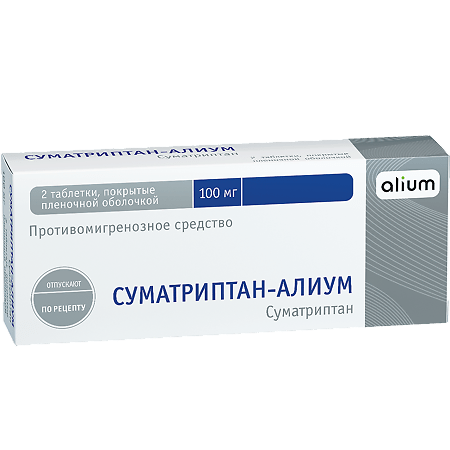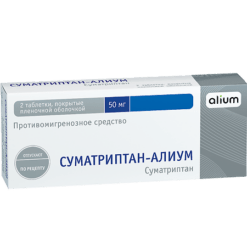No products in the cart.
Sumatriptan-Alium, 100 mg 2 pcs
€9.00 €8.22
Description
Sumatriptan is an antimigraine agent.
Pharmacodynamics
Sumatriptan is a specific selective agonist of 5NT1D-serotonin receptors (5-hydroxytryptamine-1-like) located mainly in the blood vessels of the brain. Stimulation of 5HT1D-serotonin receptors leads to vasoconstriction. The drug does not affect other subtypes of 5HT-serotonin receptors (5HT2-5HT7).
In experimental studies it is shown that sumatriptan causes selective narrowing of carotid arteries, which supply blood to extracranial and intracranial tissues, including cerebral membranes (dilation of these vessels and/or their edema is the main mechanism of migraine development in humans), while not having a significant effect on cerebral blood flow. It is also experimentally established that sumatriptan inhibits the activity of receptors of trigeminal nerve afferent fibers endings. It eliminates nausea and photophobia associated with migraine attack.
Pharmacokinetics
Absorption. After oral administration, sumatriptan is rapidly absorbed, after 45 min its plasma concentration reaches 70% of the maximum value. After oral intake of sumatriptan in a dose of 100 mg maximum plasma concentration is reached in 2-2.5 hours and averages 54 ng/ml. Absolute bioavailability when administered orally is on average 14% due to presystemic metabolism and incomplete absorption.
Distribution. Binding to plasma proteins is 14-21%, total volume of distribution averages 170 L (2.4 L/kg).
Metabolism. Sumatriptan is metabolized by oxidation with the participation of monoamine oxidase (MAO) (mainly isoenzyme A) to form metabolites, the main of which is the indole acetic analog of sumatriptan, which has no pharmacological activity against 5HT1- and 5NT2-serotonin receptors, and its glucuronide.
Elimination. The elimination half-life is 2-2.5 hours. On average, plasma clearance is 1160 ml/minute, renal clearance is 260 ml/minute. Extra renal clearance is 40% after oral administration. It is excreted by the kidneys, mainly as metabolites (97% after oral administration) of free acid or glucuronide, the rest is excreted by the intestine.
Indications
Indications
Migraine (to relieve attacks, with or without aura).
Pharmacological effect
Pharmacological effect
Sumatriptan is an antimigraine drug.
Pharmacodynamics
Sumatriptan is a specific selective agonist of 5HT1D-serotonin receptors (5-hydroxytryptamine-1-like), located primarily in the blood vessels of the brain. Stimulation of 5HT1D serotonin receptors leads to vasoconstriction. The drug does not affect other subtypes of 5HT-serotonin receptors (5HT2-5HT7).
Experimental studies have shown that sumatriptan causes selective narrowing of the carotid arteries, which supply blood to extracranial and intracranial tissues, incl. meninges (dilation of these vessels and/or their swelling is the main mechanism for the development of migraine in humans), without having a significant effect on cerebral blood flow. It has also been experimentally established that sumatriptan suppresses the activity of receptors at the endings of the afferent fibers of the trigeminal nerve. Eliminates nausea and photophobia associated with migraine attacks.
Pharmacokinetics
Suction. After oral administration, sumatriptan is rapidly absorbed; after 45 minutes its concentration in the blood plasma reaches 70% of the maximum value. After oral administration of sumatriptan at a dose of 100 mg, the maximum concentration in the blood plasma is reached after 2-2.5 hours and averages 54 ng/ml. Absolute bioavailability after oral administration averages 14% due to first-pass metabolism and incomplete absorption.
Distribution. Plasma protein binding is 14-21%, the total volume of distribution averages 170 l (2.4 l/kg).
Metabolism. Sumatriptan is metabolized by oxidation with the participation of monoamine oxidase (MAO) (mainly isoenzyme A) with the formation of metabolites, the main of which is the indoleacetic analogue of sumatriptan, which does not have pharmacological activity against 5HT1- and 5HT2-serotonin receptors, and its glucuronide.
Excretion. The half-life is 2-2.5 hours. On average, plasma clearance is 1160 ml/minute, renal clearance is 260 ml/minute. Extrarenal clearance is 40% after oral administration. It is excreted by the kidneys, mainly in the form of metabolites (97% after oral administration) of free acid or glucuronide, the rest is excreted by the intestines.
Special instructions
Special instructions
Sumatriptan is not intended for the prevention of migraine.
Sumatriptan should only be taken if the diagnosis of migraine is certain.
Sumatriptan should be used as soon as possible after the onset of a migraine attack, but the drug is equally effective at any stage of the attack. If there is no effect from the first dose, the diagnosis should be clarified. When using sumatriptan to relieve headaches in patients with previously undiagnosed migraine or migraine with atypical symptoms, other potentially dangerous neurological diseases should be excluded. It must be borne in mind that patients with migraine are at risk of developing cerebrovascular complications (including stroke or transient cerebrovascular accident).
Sumatriptan should be taken with caution in case of epilepsy and any other conditions accompanied by a decrease in the seizure threshold. In case of simultaneous use with SSRIs/SNRIs, the patient’s condition should be carefully monitored.
Before using sumatriptan, patients should exclude the presence of cardiovascular disease, especially in patients at risk. These patients include postmenopausal women, men over 40 years of age, and patients with risk factors for coronary artery disease.
The examination does not always reveal cardiovascular disease in some patients. In very rare cases, transient side effects such as chest pain and tightness may occur after taking sumatriptan. The pain can be intense and radiate to the neck (pharynx). If there is reason to believe that these symptoms may be a manifestation of coronary artery disease, it is necessary to stop taking the drug and perform a diagnostic examination.
Treatment with sumatriptan should be carried out with caution in patients with controlled arterial hypertension, since in some cases an increase in blood pressure and peripheral vascular resistance may be observed. Sumatriptan should be used with caution in patients with diseases that may significantly alter the absorption, metabolism or excretion of sumatriptan, such as impaired renal or hepatic function.
In patients with hypersensitivity to sulfonamides, when using sumatriptan, allergic reactions may develop, which range from skin manifestations to anaphylactic shock. Cross-sensitivity data are limited, but caution is warranted when administering sumatriptan to these patients.
Overuse of medications intended to treat migraine attacks is associated with increased headaches in sensitive patients (drug overuse headache).
In this case, the possibility of discontinuing the drug should be considered.
Impact on the ability to drive vehicles and control equipment
With migraine, as well as during therapy with sumatriptan, drowsiness may develop. Therefore, during the period of use of sumatriptan, care must be taken when driving vehicles and engaging in other potentially hazardous activities that require increased concentration and speed of psychomotor reactions.
Active ingredient
Active ingredient
Sumatriptan
Composition
Composition
1 film-coated tablet contains:
active substance
sumatriptan (sumatriptan succinate) 100.00 mg (140.00 mg).
Auxiliary items:
lactose,
calcium hydrogen phosphate,
magnesium stearate,
povidone.
Contraindications
Contraindications
hemiplegic, basilar or ophthalmoplegic forms of migraine;
IHD or the presence of symptoms suggesting its presence;
history of myocardial infarction;
pharmacologically uncontrolled arterial hypertension;
occlusive diseases of peripheral vessels;
stroke or transient cerebrovascular accident (including history);
severe dysfunction of the liver and kidneys;
simultaneous use with ergotamine or its derivatives and within 24 hours after their administration;
use while taking monoamine oxidase inhibitors or earlier than 2 weeks after discontinuation of these drugs;
age under 18 and over 65 years (efficacy and safety have not been established);
pregnancy;
breastfeeding (breastfeeding is possible no earlier than 24 hours after taking the drug;
congenital galactosemia, glucose/galactose malabsorption syndrome, congenital lactose deficiency;
With caution: epilepsy (including any conditions with a reduced epileptic threshold), pharmacologically controlled arterial hypertension, impaired liver or kidney function, hypersensitivity to sulfonamides (administration of sumatriptan can cause allergic reactions, the severity of which varies from skin manifestations to anaphylaxis).
Side Effects
Side Effects
From the cardiovascular system: very rarely – bradycardia, tachycardia, arrhythmia, transient increase in blood pressure (BP) (immediately after the start of treatment), transient signs of myocardial ischemia on the electrocardiogram, spasm of the coronary vessels, myocardial infarction, Raynaud’s syndrome, decrease in blood pressure, “flushes” of blood to the face.
From the respiratory system: often – shortness of breath, transient irritation of the mucous membrane or a burning sensation in the nasal cavity or throat.
From the digestive system: often – nausea, vomiting; a slight increase in the activity of liver enzymes; very rarely – ischemic colitis, diarrhea, discomfort in the abdominal area.
From the nervous system: often – dizziness, drowsiness, sensory disturbances, including paresthesia, hypoesthesia; very rarely – convulsions (usually with a history of convulsions); unknown frequency – tremor, dystonia, anxiety.
On the part of the organ of vision: infrequently – diplopia, flashing “spots” before the eyes, nystagmus, scotoma, decreased visual acuity; very rarely – partial transient loss of vision (it should be borne in mind that visual impairment may be associated with the migraine attack itself).
From the musculoskeletal system: often – myalgia; unknown frequency – stiff neck, arthralgia.
Allergic reactions: very rarely – skin rash, urticaria, itching, erythema, anaphylaxis.
Other: often – pain, tingling, feeling of heat, feeling of weakness and/or fatigue, nosebleeds, feeling of tightness or heaviness (these symptoms are usually transient, but can be intense and occur in any part of the body, including the chest and neck); unknown frequency – increased sweating.
Interaction
Interaction
When administered simultaneously with ergotamine and ergotamine-containing drugs, prolonged vasospasm is possible.
There may be an interaction between sumatriptan and MAO inhibitors (decreased metabolism of sumatriptan, increased its concentration).
With the simultaneous use of sumatriptan and drugs from the group of selective serotonin reuptake inhibitors, the development of weakness, hyperreflexia and impaired coordination of movements is possible.
There was no interaction of sumatriptan with propranolol, flunirizine, pizotifen and ethanol.
Overdose
Overdose
When administered subcutaneously at a dose of 12 mg, sumatriptan did not cause any side effects. When administered subcutaneously at a dose greater than 16 mg or when administered orally greater than 400 mg, sumatriptan did not cause any unexpected side effects other than those listed above.
Treatment: gastric lavage, taking activated charcoal, monitoring the patient’s condition for at least 10 hours, and, if necessary, symptomatic therapy. There are no data on the effect of hemodialysis and peritoneal dialysis on plasma concentrations of sumatriptan.
Storage conditions
Storage conditions
At a temperature not exceeding 25° C, in a dry place, protected from light, out of reach of children.
Shelf life
Shelf life
2 years.
Manufacturer
Manufacturer
Alium JSC, Russia
Additional information
| Shelf life | 2 years. |
|---|---|
| Conditions of storage | At a temperature not exceeding 25 ° C, in a dry, protected from light, out of the reach of children. |
| Manufacturer | Alium JSC, Russia |
| Medication form | pills |
| Brand | Alium JSC |
Other forms…
Related products
Buy Sumatriptan-Alium, 100 mg 2 pcs with delivery to USA, UK, Europe and over 120 other countries.














